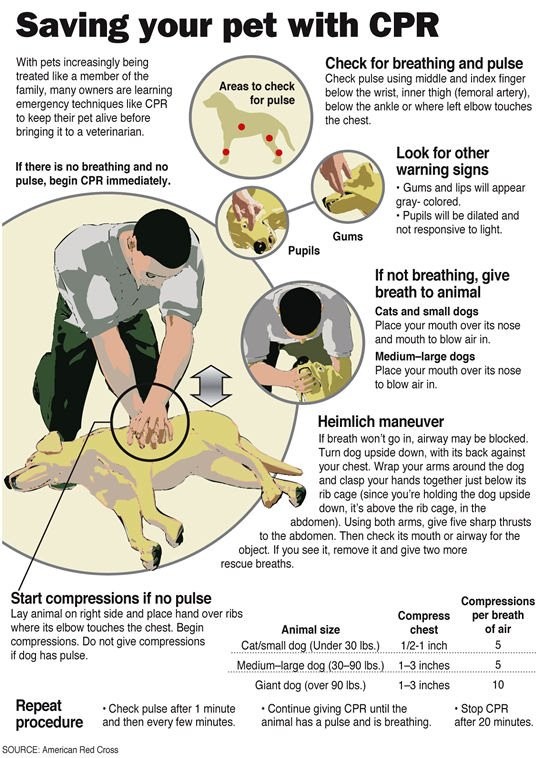With pets increasingly being treated like a member of the family, many owners are learning emergency techniques like CPR to keep their pet alive before bringing them to a veterinarian.
Print the Safety card pictured below and place it on your refrigerator today!
If there is no breathing and no pulse begin CPR immediately.
Check For Breathing And Pulse – Check pulse using middle and index finger below the wrist, inner thigh (femoral artery), below the ankle or where left elbow touches the chest.
Look For Other Warning SignsGums and lips will appear gray colored
Pupils will be dilated and not responsive to light
If Not Breathing, Give Breath To Animal
Cats And Smal Dogs – Place your mouth over its nose and mouth to blow air in.
Medium-Large Dogs – Place your mouth over its nose to blow air in.
Heimlich Manuever – If breath won’t go in, airway may be blocked. Turn dog upside down, with its back against your chest. Wrap your arms around the dog and clasp your arms around the dog and clasp your hand together just below its rib cage (since you’re holding the dog upside down, it’s above the rib cage, in the abdomen). Using both arms, give five sharp thrusts to the abdomen. Then check its mouth or airway for object. If you see it remove it and give 2 more rescue breaths.
Start Compression If No Pulse – Lay animal on right side and place hands over ribs where its elbow touches the chest. Begin compressions. Do not give compressions if dog has a pulse.
Repeat ProcedureCheck pulse after 1 minute and then after every few minutes.
Continue giving CPR until the animal has a pulse and is breathing.
Stop CPR after 20 minutes
Animal Size Compress Chest Compressions Per Breath Of Air
Cats/Small Dog (under 30 lbs) 1 1/2 – 1 inch 5
Medium-Large Dog (30-90 lbs) 1 – 3 inch 5
Giant Dog (over 90 lbs) 1 – 3 inch 10
Our thanks goes to the American Red Cross for developing such a useful infographic to teach ALL of us!
Allison Smith
www.WaggersPetSitting.com
Excellence in Pet Care since 2003
919-244-3940



